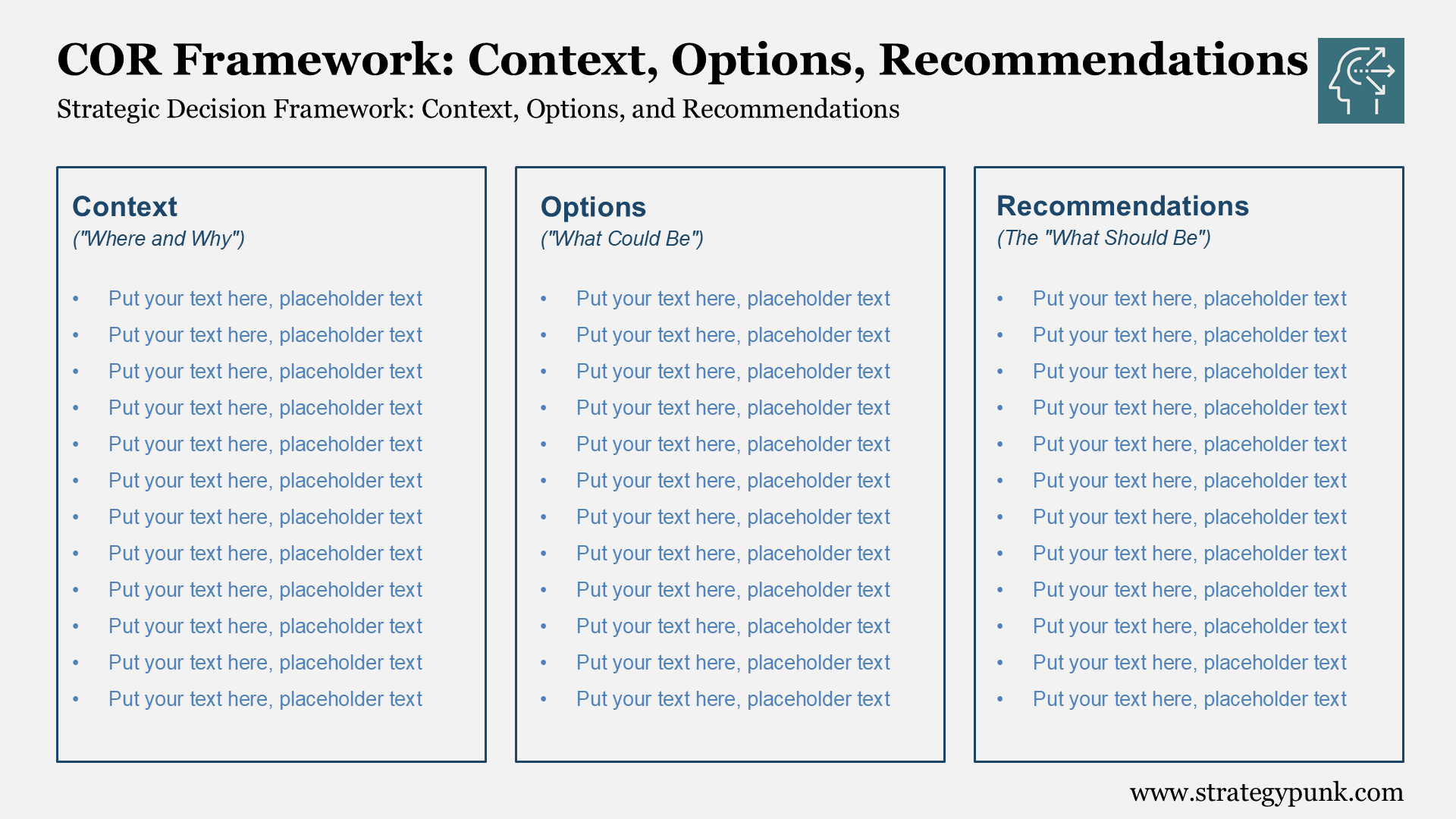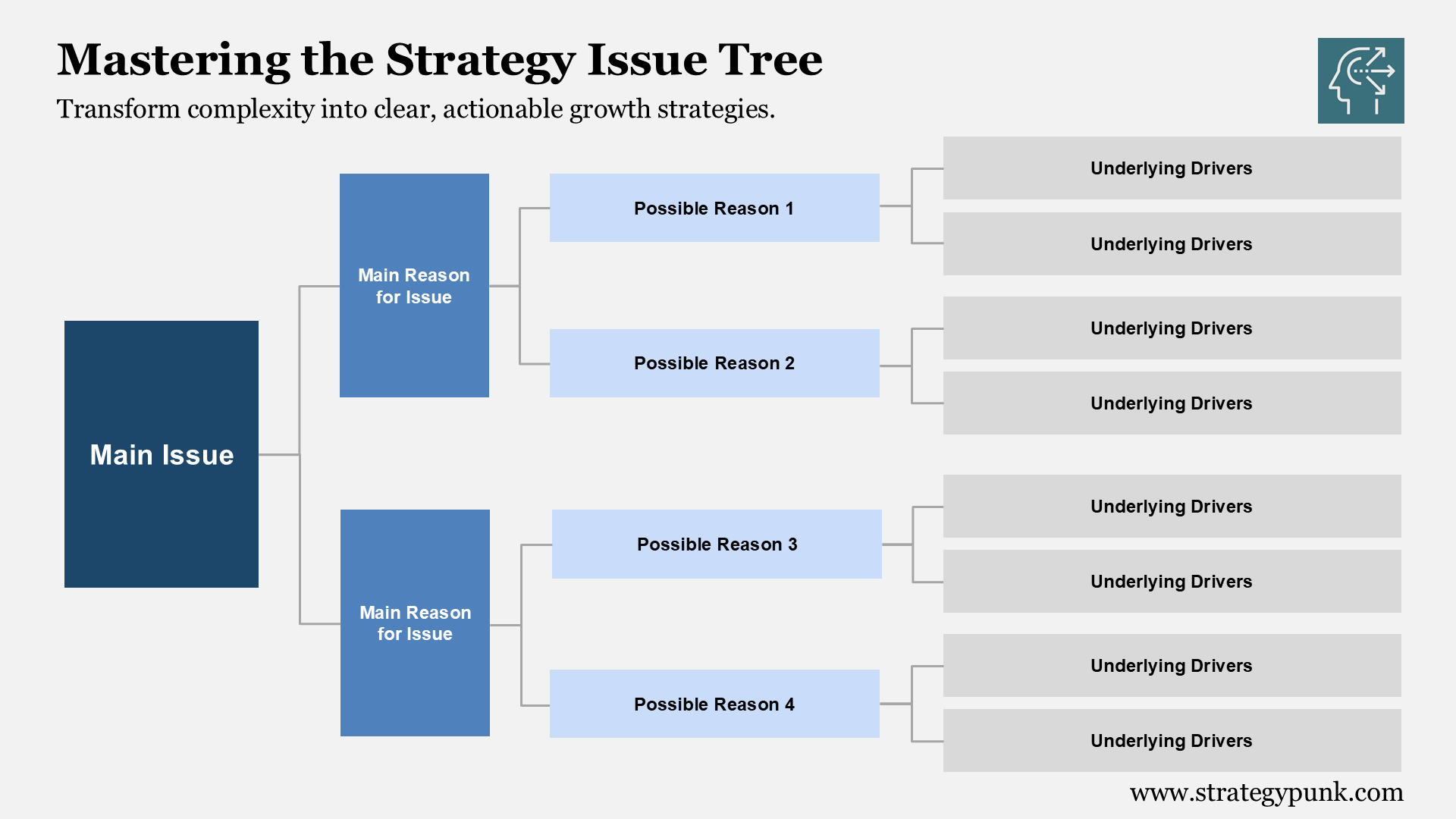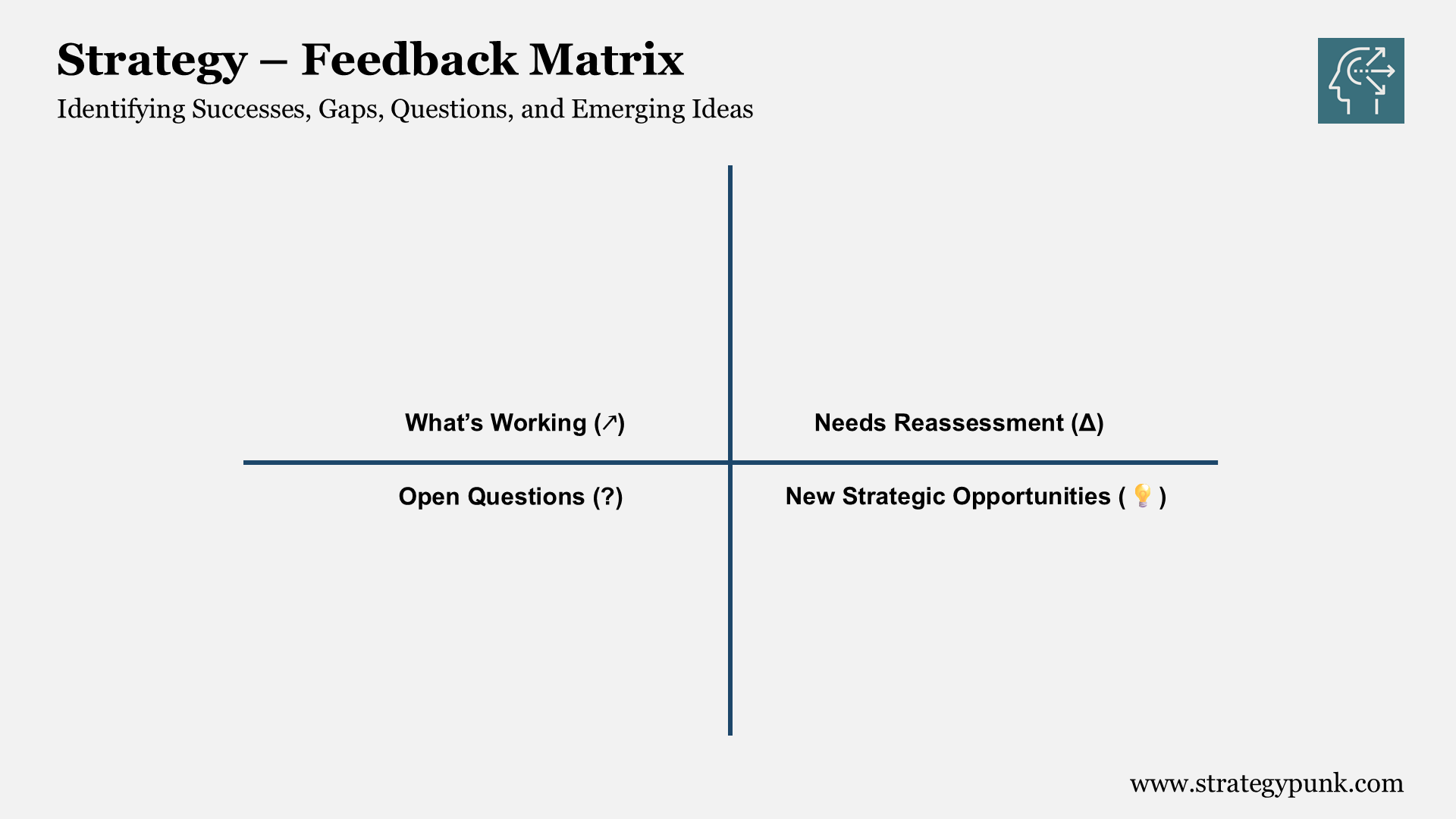Situation-Complication-Resolution (SCR) Framework: Free PowerPoint Template
The SCR (Situation-Complication-Resolution) framework offers a streamlined, structured approach for clarifying business challenges and outlining targeted strategies and solutions.
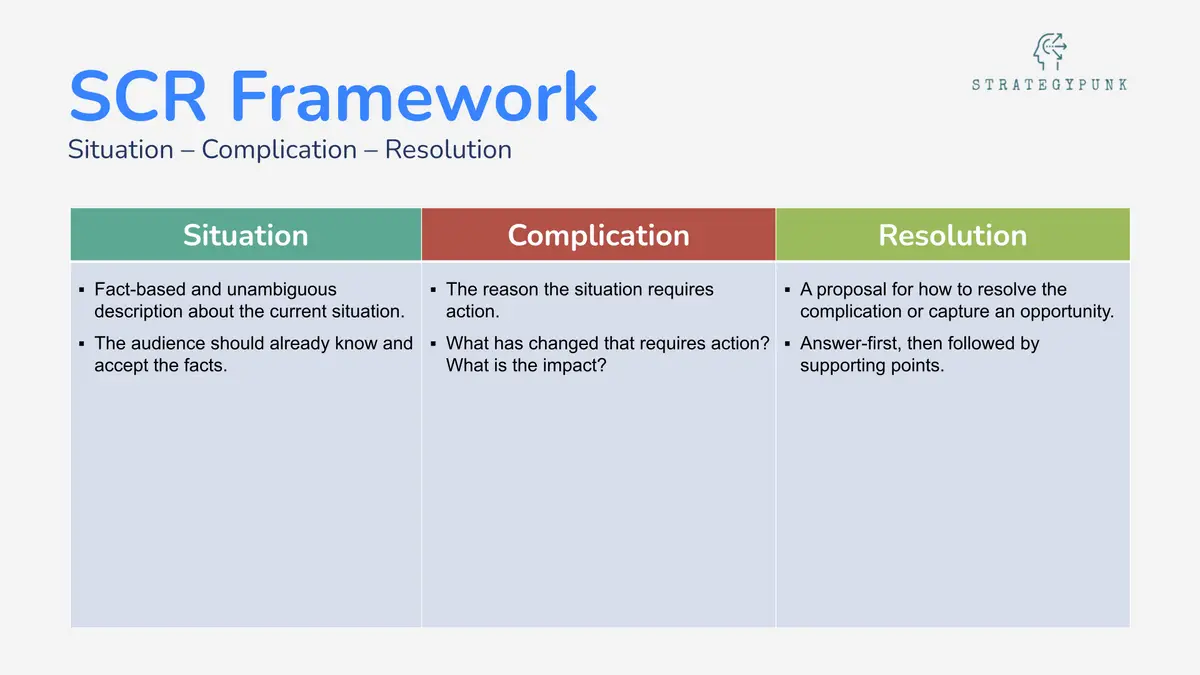
SCR Framework: Mastering Business Problem-Solving
Unlock the power of structured thinking with the SCR framework. This strategic tool empowers leaders to:
- Pinpoint current business realities
- Identify critical obstacles
- Craft targeted, actionable solutions
Elevate your decision-making process and drive meaningful change. Learn how SCR can transform your approach to complex business challenges.
The Situation Complication Resolution (SCR) framework offers a robust, streamlined approach to articulating business challenges and crafting strategic solutions. This framework stands out as a beacon of effective communication in our rapidly evolving corporate landscape, where clarity and efficiency are paramount.
Consider this: How often have you sat through meandering meetings or presentations, struggling to grasp the core issue or proposed action? This common scenario stems from a widespread gap in professional communication skills. While businesses invest heavily in technical training, explicit, structured communication should be noticed.
Yet, the SCR framework reveals a profound truth: nearly every business narrative follows a universal pattern. It begins with a status quo, faces a disruption, and demands a resolution. This mirrors the classic storytelling arc that has captivated humans for millennia. By harnessing this innate structure, the SCR method transforms complex business scenarios into compelling, actionable narratives.
Intrigued? Let's explore how this simple yet potent framework can revolutionize your problem-solving and strategic communication approach.
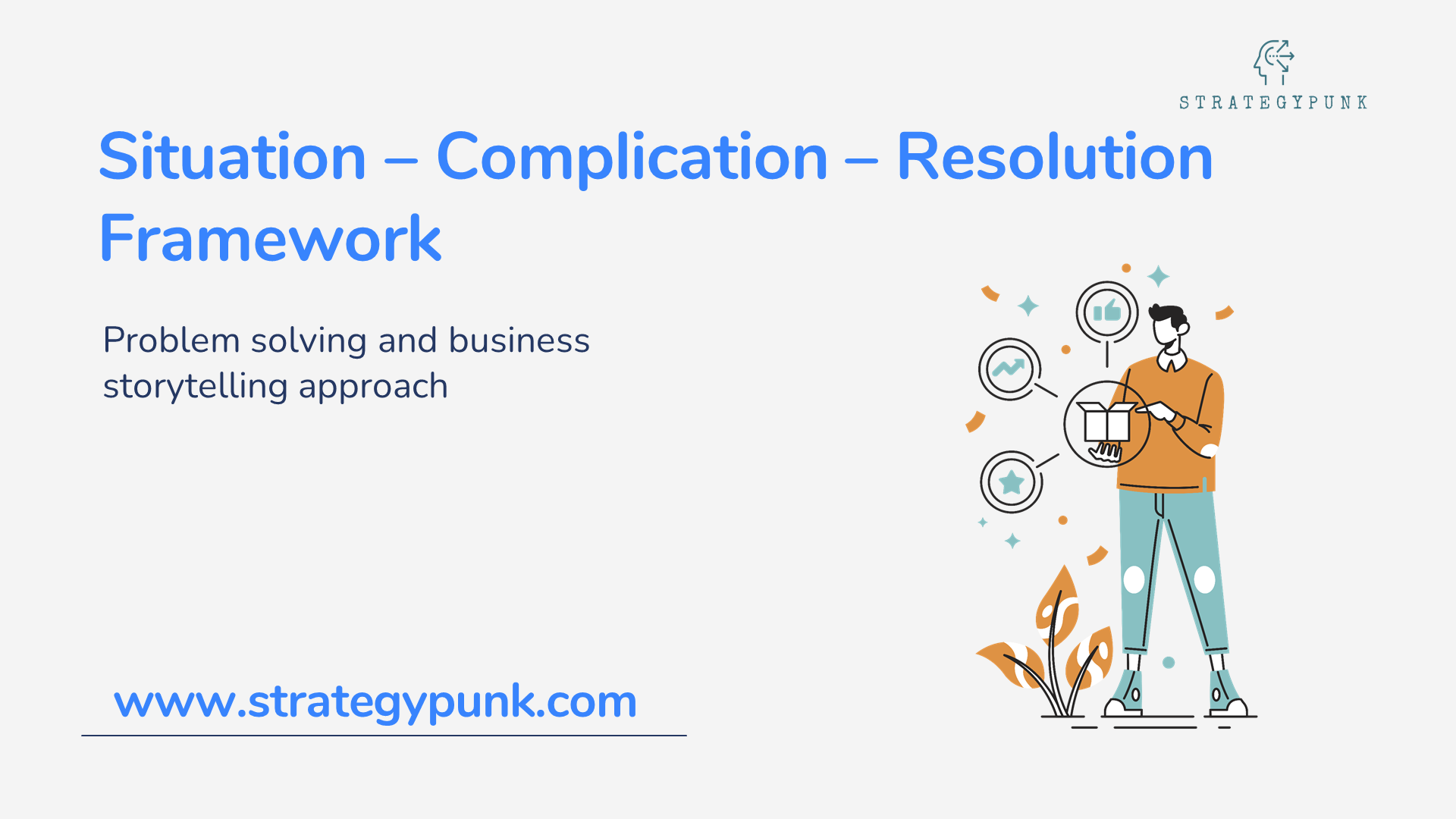



Situation-Complication-Resolution (SCR) Framework
What is situation complication resolution?
The Situation-Complication-Resolution (SCR) framework is a method for analyzing and solving problems.
It involves three steps:
- Identify the situation
- Identify the complication(s) within the situation, and
- Develop a resolution to address the complication(s).
The first step describes the situation, including any relevant background information you'd like. The second step identifies and describes the specific problem or issue within the cases. Finally, in the third step, potential solutions are generated and evaluated to determine the best action to resolve the complication.
This framework can be applied to various problems and is often used in business, project management, and decision-making.
Situation Complication Resolution (SCR) framework
The Situation-Complication-Resolution (SCR) framework provides a concise structure for clearly defining business challenges and outlining strategies and solutions. The model uses straightforward and practical reasoning or a business storytelling approach.
Management consulting firms such as McKinsey & Company, Bosten Consulting Group, Bain, etc., often use SCR models or similar models for their consultant training.
SCR is a structure that breaks a message or business challenge into three easy-to-understand parts:
Situation
Fact-based and unambiguous description of the current situation. The audience should already know and accept the facts.
Complication
The reason the situation requires action. What has changed that needs to be taken care of? What is the impact?
Resolution
A proposal for how to resolve the complication or capture an opportunity. Could you answer first, followed by supporting points?
Telling a business story using the McKinsey Situation-Complication-Resolution (SCR) framework
Telling a business story using the McKinsey Situation-Complication-Resolution (SCR) framework involves utilizing the framework to structure the story's narrative.
Here are some general steps to follow:
- Identify the situation: Clearly state the problem or opportunity the story will focus on. Could you give me some background information and context for the situation?
- Identify the complication: Could you identify the specific problem or obstacle in the situation that must be addressed? The story will focus on this critical issue.
- Develop possible solutions: Generate a list of potential solutions to address the complication. Please consider a range of options, including both short-term and long-term solutions.
- Evaluate the solutions: Analyze each solution's pros and cons and consider each option's potential impact. This will help to determine which solution is the best fit for the situation.
- Select the resolution: Choose the best solution and develop an implementation plan. This should include specific action steps and a timeline for completion.
- Tell the story: Use the SCR framework to structure the story's narrative. Begin with the situation, then describe the complication and the journey to finding the resolution. Include details and anecdotes to make the story engaging.
- Conclusion: Summarize the situation, the complication, the chosen resolution, and the outcome.
It's important to note that the SCR framework is a flexible tool that can be adapted to suit the specific needs of the problem or situation.
Also, it is essential to be clear and specific when telling the story and to include any relevant data or information to support your analysis and solution.
How do the SCR and SCQA frameworks vary from one another?
SCR (Situation, Complication, Resolution) and SCQA (Situation, Complication, Question, Answer) are established structures for effective communication and problem-solving.
However, they differ in their components and focal points.
In SCR:
Situation: It provides the current context or existing situation.
Complication: It highlights a challenge or problem within this context.
Resolution: It offers a way forward or a solution to the problem or challenge.
In SCQA:
Situation: It outlines the current context or scenario.
Complication: It identifies a problem or issue within this context.
Question: It raises a pertinent question or spots an area requiring attention.
Answer: It provides a solution or response to the identified question.
The critical distinction resides in the third component: While SCR directly offers a solution, SCQA presents a question to create a link between the identified issue and the final response. This questioning stage in SCQA aids in better defining the problem, leading to a more focused and effective resolution.
Situation Complication Resolution
Executive Summary
Here are some new perspectives on the McKinsey Situation Complication-Resolution (SCR) framework:
The SCR framework provides a structured approach to problem-solving and decision-making. By breaking down a complex issue into its parts (Situation, Complication, Resolution), the framework helps identify critical problems and develop targeted solutions.
While initially developed for management consulting, the SCR framework can be applied across industries and roles. It is a versatile communication tool to present business rationale and recommendations clearly and logically.
The framework encourages collaboration by providing a common language and thought process. Teams can work together to define the situation, identify complications, and propose resolutions.
SCR aligns stakeholders by sequentially building up the narrative. This allows the audience to follow along and arrive at the resolution recommendation.
The framework can be flexibly adapted to suit different needs, for example, by including background context before the situation or outlining multiple resolution options.
The SCR framework helps collect objective information and evaluate alternatives for complex decisions. Additional decision support tools may be needed to facilitate the resolution analysis.
Consistently applying the SCR framework can help individuals and organizations improve problem-solving practices and make better quality decisions.
As a communication tool, the SCR framework emphasizes clarity, specificity, and practical action steps. This prevents misalignment and saves time.
In summary, the SCR framework provides a versatile and structured approach to critical thinking that can be applied across diverse situations and industries.
It enables collaboration, aligns stakeholders, and drives quality decision-making. Through thoughtful application, the framework is highly adaptable to different needs.
Situation Complication Resolution Template
free and fully editable template in PowerPoint and Google Slides
The Situation-Complication-Resolution (SCR) framework is a method for analyzing and solving problems.
It involves identifying a situation and its complication(s) and developing a resolution to address the difficulty (s).
It is often used in business, project management, and decision-making and can be applied to various problems.
The SCR framework can be used to structure a narrative in a business story and make it engaging and easy to understand. It is a flexible and powerful tool that can be adapted to any problem or situation.
Has my work made a difference for you? I'd be grateful for your support. Your contribution helps me continue creating high-quality resources.



